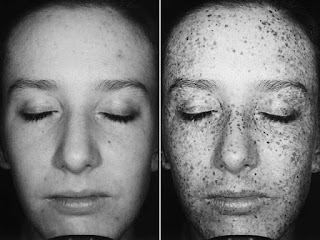 |
| source |
Hormone shifts triggered by birth control pills, pregnancy, thyroid conditions and menopause are the most common causes of melasma. Hormonal changes can cause melanin production to spike. Melasma is thought to occur when melanocytes, the cells that produce melanin, are stimulated by female hormones such as estrogen and progesterone. This hormonal stimulation causes melanin to produce more pigments when exposed to sunlight.
Both men and women can develop melasma, however its much more common in women. Some people may be genetically predisposed to developing melasma. People with darker skin such as African, African American, Asian, Indian, Latin/Hispanic, Mediterranean and Middle Eastern descent are more prone to hyperpigmentation and melasma. This is because the melanocytes are more active in darker skin tones.
- Epidermal melasma
- occurs in superficial layers of the skin
- well-defined borders
- typically dark brown in color
- responds very well to treatment
- Dermal melasma
- occurs in deeper layers of the skin
- undefined borders
- light brown or blueish in color
- Mixed melasma
- a combination of epidermal and dermal melasma
- most common type of melasma
- mix of light brown, dark brown and blueish in color
All cases of melasma start out in the epidermis, the outermost layer of skin. Dermal melasma occurs when the affected cells are inflamed or over irritated. Inflammation can cause a temporary split between the dermis and epidermis allowing cells from melasma drop from the epidermis into the dermis. Once in the dermis, melasma is very difficult to treat because the cells become resistant to topical treatments.

